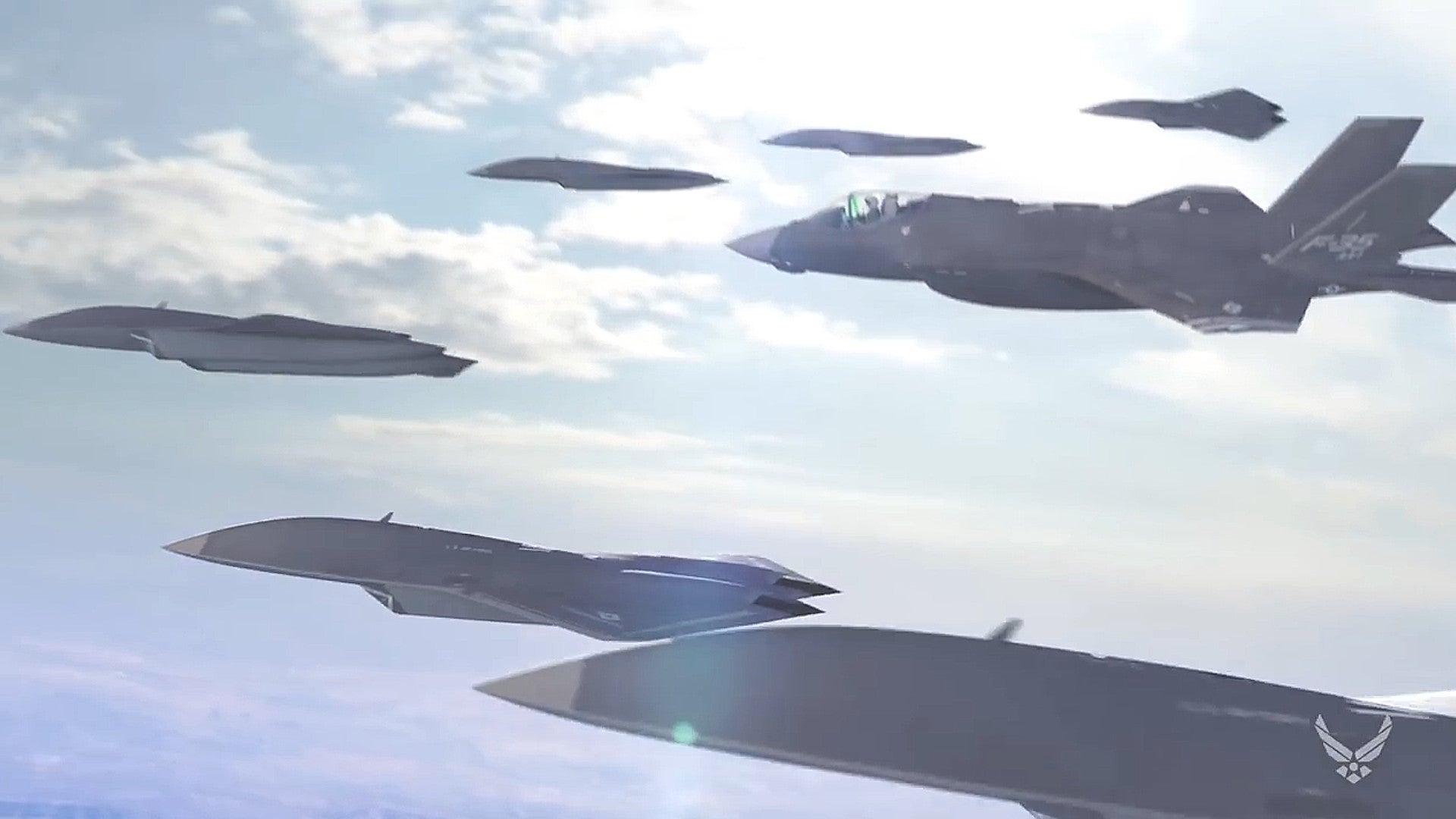As part of a broader initiative to invigorate its advanced science and technology work and promote increased partnerships with academia, the U.S. Air Force has released a short video depicting how it thinks aerial warfare might look by the end of the next decade. It’s a futuristic, but in many ways incomplete vision full of advanced stealthy manned jets, semi-autonomous unmanned combat air vehicles, lasers and other directed energy weapons, and a potentially artificial intelligence-enabled network backbone that brings it all together.
The Air Force Research Laboratory (AFRL), one of the service’s top research and development arms, put the clip online earlier in March 2018 as a “call to action” for the Air Force 2030 project. Secretary of the Air Force Heather Wilson first announced this plan at the Air Force Association’s main annual convention and exhibition in 2017, which also marked the Air Force’s 70th year in existence.
“We will listen broadly and engage those who are on the cutting edge of science so that we can focus our research efforts on the pathways that are vital to our future as a service,” she said in her keynote address on Sept. 18, 2017. “At a time when federal research funding may be uncertain we want the United States Air Force to be the sponsor of choice for research scientists.”

But it’s clear that AFRL, and the Air Force as a whole, already has some understanding of the kind of capabilities it is most interested in pursuing. After giving a brief overview of the service’s already significant history of science and technology research and development work, the Air Force 2030 video cuts to a computer generated montage of advanced air warfare concepts.
Loyal Wingmen
The first scene depicts an F-35A Joint Strike Fighter working together with six stealth unmanned combat air vehicles, or UCAVs. For years now, the Air Force, and AFRL in particular, has been working on this type of manned-unmanned teaming, which it has referred to as the “Loyal Wingman” concept.
In 2015, Lockheed Martin, in cooperation with the CalSpan Corporation, demonstrated the ability of a two-seat Block 50 F-16D Viper to safely fly in formation with a modified unmanned F-16 test bed, known as the Variable stability In-flight Simulator Test Aircraft, or VISTA. At times during that test, known Have Raider, the drone Viper also broke off, followed a pre-determined route independently, and then re-entered formation with the manned aircraft.

Two years later, during a follow on experiment called Have Raider II, the pair of aircraft actually went through the motions of a simulated strike mission. The pilotless F-16 attacked simulated targets on the ground autonomously based on an established set of parameters, but also modified its flight pattern in response to mock threats and other changing environmental conditions.
AFRL has since released concept art of a more purpose built drone wingman under a project called Low Cost Attritable Aircraft Technology (LCAAT). That design looked very similar to the XQ-222 Valkyrie, a multi-purpose unmanned aircraft from drone maker Kratos that the U.S. Air Force also calls the XQ-58A.
Kratos recently received approval to export its less advanced UTAP-22 Mako drone, which it has tested in a loyal wingman role in the past with a U.S. Marine Corps AV-8B Harrier, which suggests that there could be more advanced designs from that company or others in a relatively mature state already available to the Air Force. With some notable exceptions, the United States is typically not inclined to make military systems available even to allies that are directly equivalent to its own top-end capabilities.

Stealthy unmanned attackers
The March 2018 video shows much more advanced loyal wingmen with completely tailless, low-observable planforms, internal weapons bays, and an in-flight refueling receptacle on top of the fuselage. Both the Air Force and the U.S. Navy have demonstrated the ability to refuel an unmanned aircraft in mid-air and the former service may have actually deployed drones with this capability.
Coupled with mid-air refueling, such a force could potentially penetrate deep into denied enemy areas full of integrated air defenses and advanced hostile fighter aircraft to destroy critical or time sensitive targets. The group would also be able to strike at those defenses, helping open up a safer path for subsequent strikes by more vulnerable non-stealthy aircraft.
In the video, the pilot in the F-35A uses the aircraft’s advance sensor suite to detect a surface-to-air missile site and orders some of his drone companions to attack it with what appears to be a GBU-39/B Small Diameter Bomb (SDB) glide bomb. This combination of a manned low-observable plane directing stealthy UCAVs to hit a target with a stand-off weapon shows just how much distance a pilot might be able to put between themselves and a threat with this operating concept.
Similar operating concepts could apply in air-to-air combat, as well, with the drones acting as missile trucks, engaging targets based on information from the controlling F-35 or another manned or unmanned asset loaded with sensors. It could also potentially help with the Air Force’s chronic pilot shortage by significantly expanding the capabilities a single manned aircraft can bring to bear across a broad area.

Netcentric warfare
It only gets a brief and very narrow interlude in the video, but its important to note that these operations would almost certainly rely heavily on robust data links and other networked communication nodes, in the air, on the ground, and in space to rapidly relay information back and forth between manned and unmanned aircraft and other friendly forces. AFRL’s presentation shows how this might allow headquarters and air operations centers in the ground to monitor a pilots vital signs and life support systems specifically.
This is a particularly important consideration given a growing number of reported cases of hypoxia-like symptoms among aviators across the U.S. military flying a variety of fixed-wing aircraft. Hypoxia refers to a dangerous drop in oxygen getting to the brain, or an outright stop in the flow altogether, which can cause disorientation, blackouts, and even death, and is particularly dangerous for pilots. The Air Force has had to deal with these issues with regards to a wide variety of aircraft, including the F-35, the F-22 Raptor stealth fighter, the A-10 Warthog ground attack aircraft, and the T-6 Texan II turboprop trainer. Being able to keep an eye on these issues remotely could help prevent potentially deadly accidents.

Beyond that, though, networked systems will also give pilots and increasingly detailed picture of the battlefield during actual operations by fuzing together different types of data from various sources. Advanced artificial intelligence may be able to help parse that information, as well, speeding up a pilot’s decision making process by weeding out low-priority data and focusing on the most significant threats.
In the video, the F-35 pilot appears to speak with a disembodied head, which could be a stand-in for an augmented reality communications system with other individuals or represent an artificial intelligence adviser of sorts explaining the situation at hand. There is the implication here that in the future a pilot may be able to issue commands to their networked wingmen using voice commands through this sort of interface, too.

Drone swarms
The AFRL video then moves on to a different drone concept, involving a canister-like module that dispenses dozens of small unmanned aircraft that work together as a swarm. The clip shows a humanoid robot pushing the entire system out the back of a C-130-type airlifter, after which a parachute deploys, suspending the system in midair, allowing the tiny planes to break off and go zipping along toward their targets.
At present, the Defense Advanced Research Projects Agency (DARPA), the Pentagon’s top advanced research and development entity, is leading this work as part of a project it calls Gremlins. Still very much in the conceptual stage, the goal for the program is to develop a system that bombers or cargo aircraft, and possibly even fighter jets, can deploy, while a C-130-sized aircraft recovers the unmanned planes after the mission if necessary.
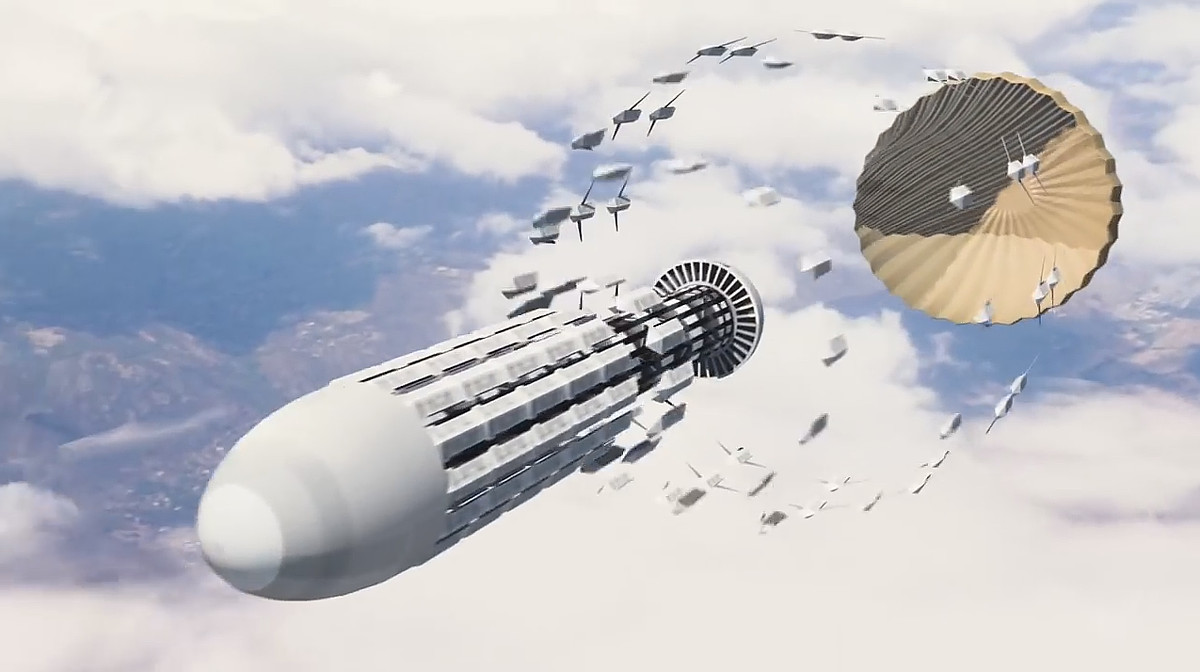
As we at The War Zone have written about in depth
many times before, these swarms have the potential to offer intelligence, surveillance, and reconnaissance capabilities over a broad area, as well as the ability to confuse or otherwise disrupt enemy defenses. Depending on their exact size and capabilities, they might also be able to function as munitions themselves or conduct non-kinetic attacks using electronic warfare jammers or other systems.
With that in mind, AFRL itself is working separately on a project called Gray Wolf, which aims to develop a swarming, low-cost cruise missile type weapon. the Air Force hopes it may be able to leverage the same shell to carry different, non-kentic payloads eventually.
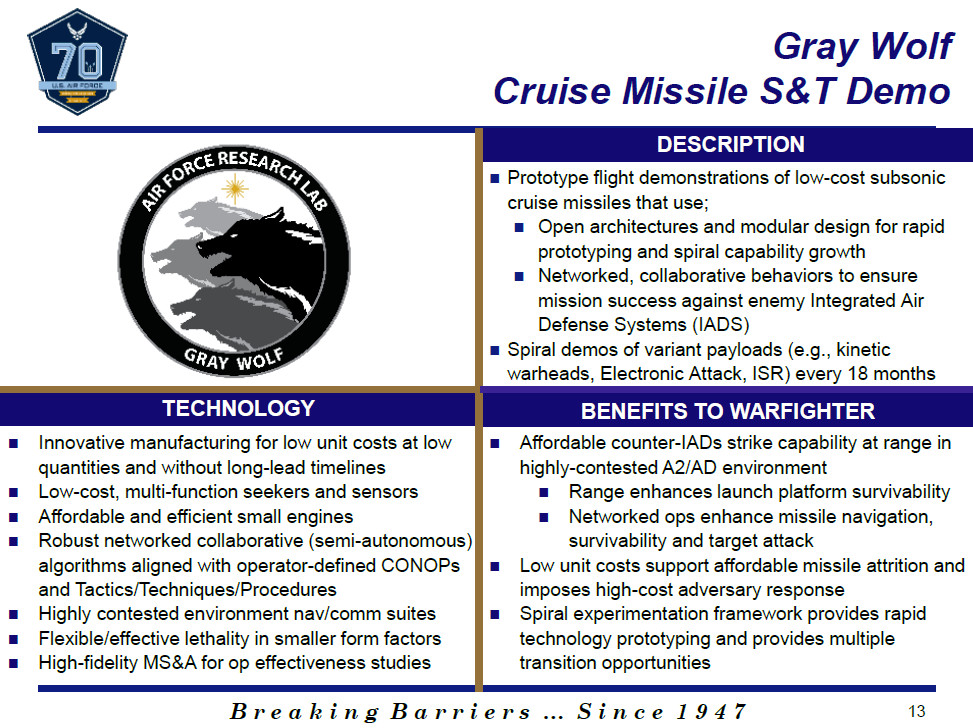
Microwave cruise missiles
After all the drones, the video moves on to two depictions of advanced munitions and aircraft weapons. The first of these involves a B-2 Spirit stealth bomber launching a cruise missile that blacks out a city.
Together with Boeing, AFRL has actually already demonstrated the first capability in tests of a weapon known as the Counter-electronics High Power Microwave Advanced Missile Project (CHAMP). This system used the body of an AGM-86 Conventional Air Launched Cruise Missile (CALCM) to carry a still classified payload that uses microwave pulses to disable electronic devices.
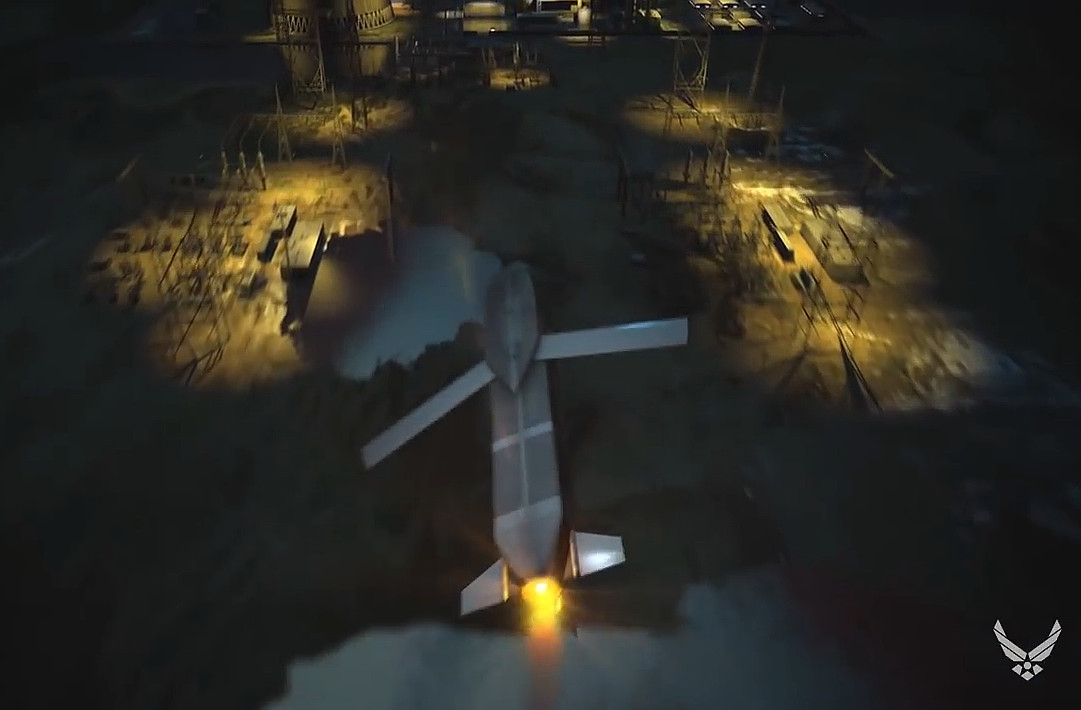
Since then, the Navy appears to have taken the lead on this project, which it refers to High-power Joint Electromagnetic Non-Kinetic Strike, or HIJENKS. The Air Force remains actively involved, though, and reportedly is responsible for the payload that will go into the prototype weapons.
The exact shell for this new system is unclear, but there were reports in the past that the stealthy AGM-158B Joint Air to Surface Standoff Missile-Extended Range (JASSM-ER) could be the basis for the new weapon. This would make sense, as this system has a number of improved features over the older AGM-86s that make it harder for an enemy to detect and potentially shoot down.
In turn, this could improve its ability to sneak into a denied area and neutralize an opponent’s key sensor networks and command and control nodes, blinding them to subsequent operations and throwing their response procedures into chaos. This gives such a weapon a powerful psychological, as well as function capability, as an enemy has no idea about the size and direction of what might be coming next. Depending on the specific platform carrying the system, it might not even be possible for them to initially determine the source of this non-kinetic strike, if at all.
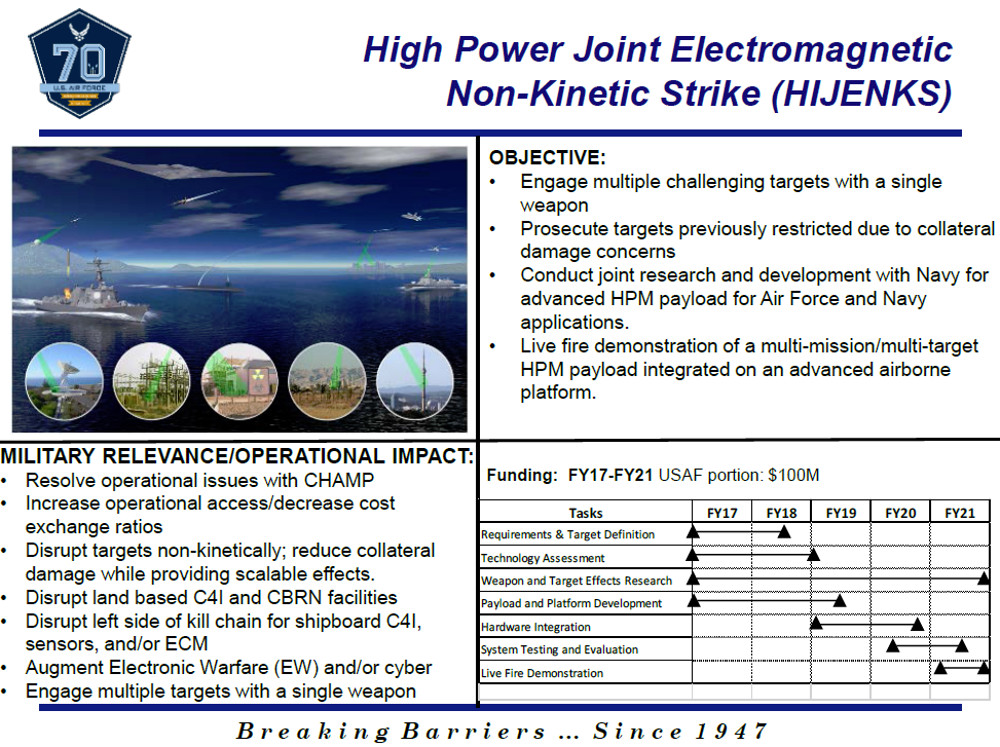
Laser-armed sixth generation fighters
The video ends on a clip of a notional sixth generation fighter employing a laser weapon to shoot down an enemy aircraft. This combination is also something the Air Force has expressed an interest in and maybe closer to reality than some might think.
AFRL is leading a project to develop an experimental podded solid-state laser weapon for fighter jets under the Self-protect High Energy Laser Demonstrator (SHiELD) program. The main goal there is to demonstrate a system that would be able to shoot down incoming missiles.
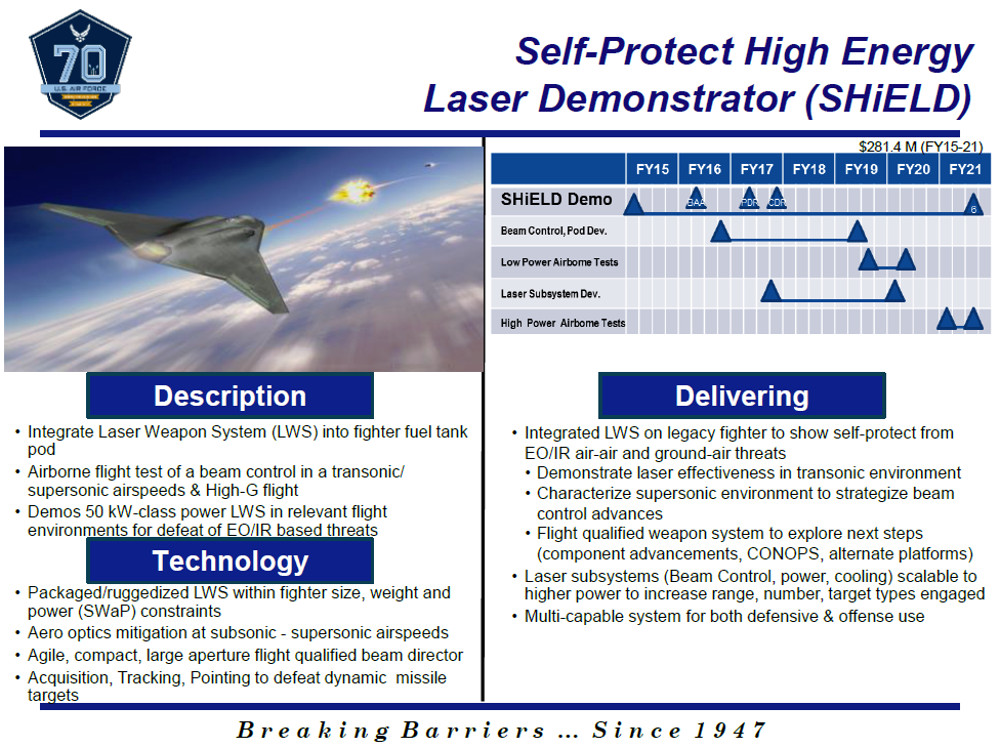
But if this arrangement works, it could provide a starting place for an offensive directed energy weapon. Such a system could theoretically work in both air-to-air and air-to-ground roles and could offer a host of advantages over more traditional guns, missiles, and bombs.
The inherent ability of a laser focus its beam narrowly on a particular point could improve overall accuracy and help limit collateral damage during air strikes, especially in constrained environments such as densely populated urban areas, which is itself an increasing topic of concern across the Pentagon. Depending on the exact nature of the power source, it could also offer an effectively “bottomless magazine,” allowing an aircraft to remain on station and armed for a protracted period of time, even after engaging multiple targets.

And though the video shows a tailless sixth generation stealth fighter shooting down another aircraft in a stereotypical dogfight, the Air Force is still in the process of outlining what it wants from this future aircraft. In its latest budget request for the 2019 fiscal year, which it released in February 2018, the service asked for more than $500 million to continue work on this Next Generation Air Dominance (NGAD) platform, which it has also referred to in the past as Penetrating Counter Air (PCA).
This amount is nearly double what the Air Force asked for to support the NGAD program in the 2018 fiscal year. At present, there is little firm information about what this aircraft might look like beyond the service’s desire for it to be capable of flying for extended periods at supersonic speeds and be even more low-observable in order to avoid and defeat existing and emerging threats, have a long range to help give it more independence from increasingly vulnerable aerial refueling tankers, and just generally be able to operate persistently in denied areas. At present, the indication is that the goal is still have a piloted platform, but unmanned systems are increasingly the way of the future and the final design, however it evolves, may turn out to be at least pilot optional.
“We believe you have to go fight the enemy in their airspace if you want to make air superiority work,” U.S. Air Force General Mike Holmes, head of the service’s Air Combat Command, said in 2017. “Certainly we think we’re going to pursue counter-air, we’re going to pursue suppression and destruction of enemy air defenses, we’re going to have to pursue an electronic warfare component of that.”
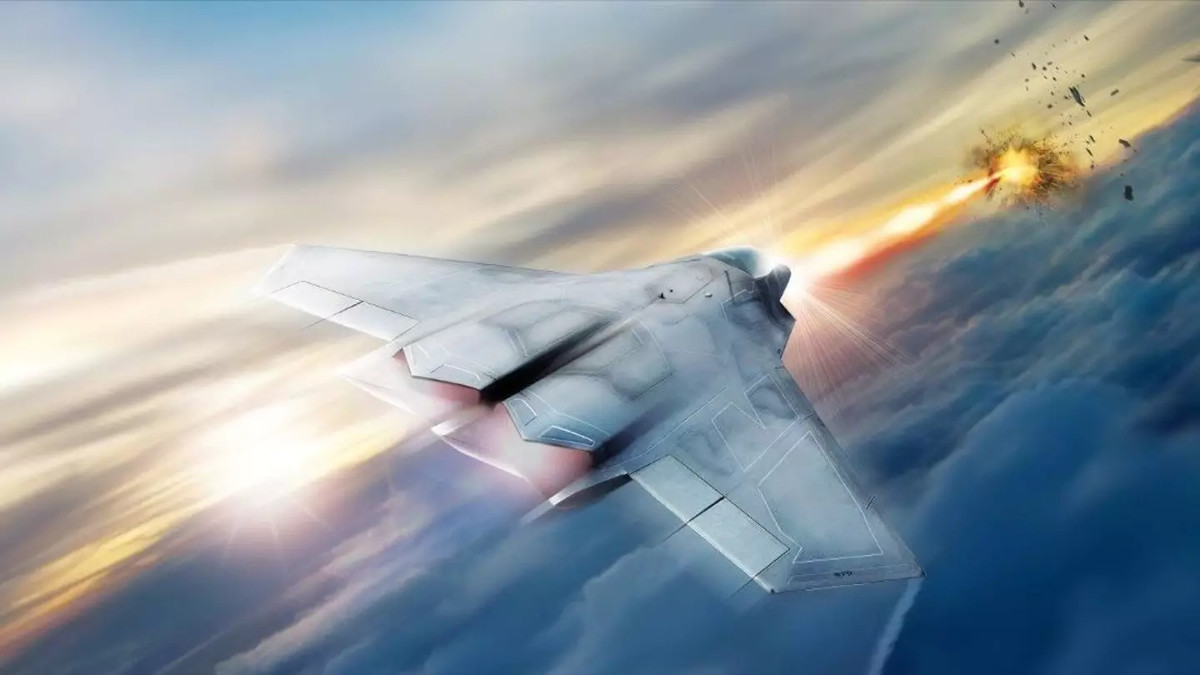
A new air warfare paradigm
It’s an aircraft that will fit into this otherwise potentially revolutionary concept of aerial warfare. At least one concept study has even pointedly attempted to avoid using a notional “F-X” nomenclature, suggesting that the Air Force believes the final design will be functionally distinct from previous fighter jets.
An aircraft that flies together with loyal wingmen drones, engages with swarms of smaller unmanned aircraft or munitions, and carries advanced kinetic and non-kinetic weapons, could definitely fit that description. Like these other capabilities, the Air Force hopes that the NGAD will begin to enter service sometime in the 2030s.
It’s an ambitious set of goal with an equally aggressive schedule, but the Air Force believes this is necessary in order to maintain its dominance over potential opponents, especially Russia and China. The U.S. military as a whole is increasingly sounding the alarm that those countries are pursuing their own increasingly advanced military projects that are closing the capability gap, directly or indirectly, between them and the United States.
“China’s impressive military buildup could soon challenge the United States across almost every domain,” U.S. Navy Admiral Harry Harris, head of U.S. Pacific Command told members of congress earlier in 2018. “We don’t have any defense that could deny the employment of such a [hypersonic] weapon against us” by Russia or China, U.S. Air Force General John Hyten, head of U.S. Strategic Command, told legislators more recently in March 2018.
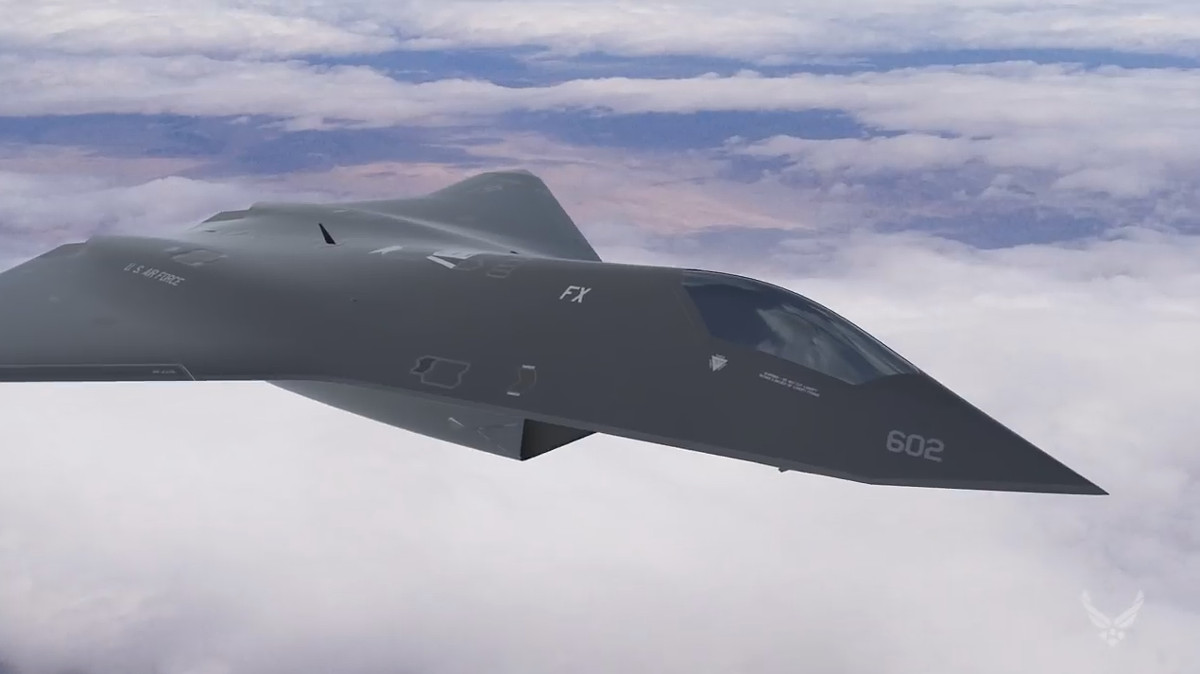
Finding the funds and resources to keep these research and development programs on pace while trying to sustain an increasingly complex force may pose serious challenges for the Air Force, though. The service is in the process of trying to ramp up F-35s, purchase new B-21 Raider stealth bombers, and just pay for the aircraft, personnel, and other assets it already has, which continues to be a struggle, among a host of other projects.
It’s also worth noting that many of these and other critical assets are curiously absent from this video, including the B-21, advanced intelligence, surveillance, and reconnaissance platforms, new aerial refueling tankers, fully autonomous UCAVs, and anything space related. That latter topic is already important will only continue to become more so in the near future for a host of different reasons.
The need for more resources in general and the desire to potentially share those burdens more broadly among the reasons why AFRL and the Air Force are looking to increase their partnerships with academic institutions and private industry. This desire for more cooperative research and development in order to speed up the process overall was a significant theme in Secretary of the Air Force Wilson’s remarks in September 2017.
“We want to use methods and organizational structures that best support university-based research so that we simultaneously benefit from the work that is done and develop the next generation of American engineers and scientists that we will need as a service to take us forward into the next frontier,” she said. This strategy “will define our highest research priorities to be sure, but it will also help us strengthen new relationships between our Air Force and the science community, our universities, and our industry partners.”
And beyond just showing a potential future of air combat, AFRL’s video is, as noted, a call to action. If you think you have your own good idea, you can go to the Air Force 2030 website right now and let them know.
Contact the author: jtrevithickpr@gmail.com
